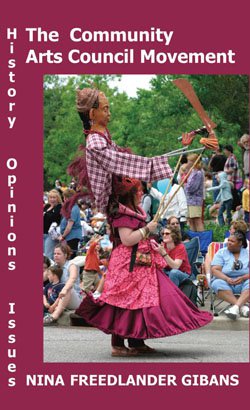
About the Author
Nina Freedlander Gibans is a graduate of Sarah Lawrence College and earned her M.A. in Aesthetics and Art History from CASE Western Reserve University. She has been the director of the Cleveland Area Arts Council and a staff member at the Cleveland Museum of Art and the Cleveland Children’s Museum, and she has been involved in both teaching and directing of major public programs. She has also been an art critic. This was her first of four books including one of poetry and seminal books on the Children’s Museum field and Cleveland’s art and architecture. She has created and produced five public videos, one of which, Creative Essence: Cleveland’s Sense of Place, was selected for inclusion in the Cleveland International Film Festival. Arts Management Magazine awarded her their annual arts management award.
THE COMMUNITY ARTS COUNCIL MOVEMENT: History, Opinions, Issues
Nina Freedlander GibansNew Academia Publishing, 2006
360 Pages
ISBN 0-9777908-3-5 Paperback
For BULK ORDERS, order directly from New Academia Publishing.
Queries: orders@newacademia.com
About the Author
Nina Freedlander Gibans is a graduate of Sarah Lawrence College and earned her M.A. in Aesthetics and Art History from CASE Western Reserve University. She has been the director of the Cleveland Area Arts Council and a staff member at the Cleveland Museum of Art and the Cleveland Children’s Museum, and she has been involved in both teaching and directing of major public programs. She has also been an art critic. This was her first of four books including one of poetry and seminal books on the Children’s Museum field and Cleveland’s art and architecture. She has created and produced five public videos, one of which, Creative Essence: Cleveland’s Sense of Place, was selected for inclusion in the Cleveland International Film Festival. Arts Management Magazine awarded her their annual arts management award.
About the book
It has been twenty-five years from the first printing of The Community Arts Council Movement: History, Opinions and Issues. So, what has changed? What is similar?
Reviewing recent summaries of anniversaries and activities, one is struck by the resonance of the original concerns and the progress made: recognizing and keeping community arts issues a priority; enabling the partnership among federal, state and local partners; developing a voice for effective advocacy.
Research for the book includes written materials from various councils; about 150 discussions with specialists and practitioners from urban councils and regional, county and rural organizations; and questionnaires completed by movement founders, community arts administrator trainers, and local and national political figures who have promoted community arts to their peers.
The cover picture for the second printing of this book is of “Parade the Circle,” an annual community arts event in Cleveland Ohio. It is one event now eligible for public funding thanks to the concerted effort of arts organizations and non-profit agencies over the course of 8 years.
Praise
“This book should be required reading in order to understand the historical context of our own efforts as we map the future of the arts in our communities.”
– Peggy Spaeth, Director of Heights Arts
“From arts administrators and arts educators, to government officials and interested citizens, this book has played a key role in illuminating the work of the nonprofit arts in America.”
– Robert L. Lynch, President and CEO, Americans for the Arts





 Coming Soon
Coming Soon Awards
Awards